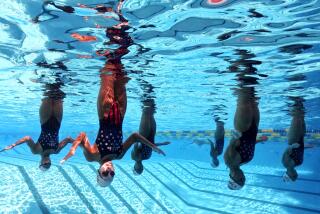TRACK AND FIELD / JULIE CART : Larrieu-Smith’s U.S. Record at 38 Should Come as Surprise to No One
Anyone who was surprised at Francie Larrieu-Smith’s breaking of the American record at 10,000 meters last Thursday night is either being silly or has not been paying attention the past 20 years.
And to those who remarked that, at age 38, Larrieu-Smith has no business running that fast, her simple answer is “Pah!”
Larrieu-Smith broke Mary Slaney’s nine-year-old record while running with with no competition and through light rain at the Texas Relays at Austin. Her time of 31 minutes 28.92 seconds was 6.83 seconds faster than Slaney’s record. The race was Larrieu-Smith’s first since placing fifth in the 10,000 at the Seoul Olympics, and it was far removed from the pageantry of the Olympic race.
“I wouldn’t call it a walk in the park,” she said from her home in Dallas. “To begin with, the Relays really start on Friday, so there was no one in the stands, no one. The only people were some decathletes and their coaches and some distance runners who had stayed around.
“I was nervous, but I felt really good. I knew--based on some times I had run recently--that I could do well. I also knew the field was not that strong, so I would have to run alone. But it worked out well. After the second lap I was lapping people. So I had other runners to key on. I think the difference for me was that I was really focused.”
Larrieu-Smith said she was running to make the World Championship qualifying standard and didn’t think of a record. In fact, the stadium clock was four seconds fast and she had to rely on meet officials to yell out split times. That worked out well--she has been competing at the Texas Relays for 18 years and most of the officials know her well.
Most people who follow track know Larrieu-Smith well. She’s gone from running 880s as a San Jose Cindergal to marathons--she will run in the London Marathon April 21. Larrieu-Smith competed at 1,500 meters for much of her career, mainly because, until the 1984 Olympics, that was longest championship distance women were allowed to run.
It is the leg speed developed over years in the middle distances that make Larrieu-Smith such a dangerous distance runner.
“I consider it my strongest ally,” she said. “I always tell everyone, ‘You don’t want to be in the last 100 yards of a race with me.’ But the problem is getting there.”
While her career has been exceptionally long, Larrieu-Smith said that because she has run such short distances, she hasn’t put the mileage and stress on her legs that a young runner might today. Even now she has been conservative in her approach to marathons. She ran her first in 1986 and has run only three. Her training now has been geared toward marathons, making her 10,000 record a surprise. With a 2:28.01 personal best in the 26-mile, 385-yard race, Larrieu-Smith is making progress in a competitive event.
But is she too late, at age 38?
“Heck, no,” she said. “Look at Carlos Lopes and Priscilla Welch. Age is not a factor, in any way, for me. My years of experience have helped me. I’m looking to make the U.S. team in 1992 at the marathon. I want to run in Barcelona.”
Don’t be surprised if she does.
The International Olympic Committee sent a fact-finding delegation to South Africa two weeks ago with much fanfare. Now it’s the International Amateur Athletic Federation’s turn. Track and field’s international governing body will send its own delegation to South Africa this month to report its findings at an IAAF meeting next month.
The delegation will observe the operations of the South African Amateur Athletic Union, which provisionally governs the sport in South Africa, as well as tour facilities, and meet with officials from all sides. The goal is to assess the nation’s progress toward reinstatement to the IAAF.
While the IOC has set down five conditions for South Africa’s reinstatement--which some predict could come in time for the 1992 Barcelona Olympics--the IAAF has no guidelines other than its own bylaws and statements made by IAAF officials.
Like the IOC, the IAAF would require an end to apartheid, the system of racial separation that prompted the boycotts and bans of South Africa that began 30 years ago. Like the IOC, the IAAF has rules that say its member nations must provide free and open competition for all citizens.
And like the IOC, the IAAF would like to claim credit for bringing South Africa back into the family of international sporting nations. South Africa was a founding member of the IAAF and its reinstatement to the IAAF would be seen as something of a precedent that might set the wheels in motion for South Africa’s recognition by other international governing bodies.
Not coincidentally, track and field is the sport where South African athletes would have the most impact. The nation’s reinstatement would make eligible an array of new faces and stars that would no doubt inject great interest into a sport that has seen interest lag in some parts of the world. And since many of South Africa’s best athletes are black, the IAAF gets points for giving oppressed athletes and opportunity.
Doesn’t sound like a difficult decision for the IAAF. Look for a South African team to compete, for the first time, at the African Games in September at Cairo.
Track Notes
The 160-member U.S. Olympic track and field team will train in Narbonne, France, at staggered intervals from July 7 through Aug. 4, 1992, in preparation for the Barcelona Games. Narbonne is a 90-minute from Barcelona.
More to Read
Go beyond the scoreboard
Get the latest on L.A.'s teams in the daily Sports Report newsletter.
You may occasionally receive promotional content from the Los Angeles Times.





